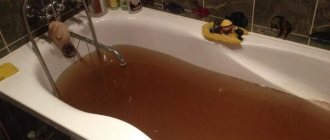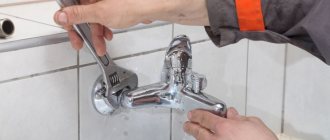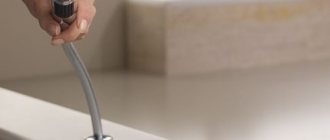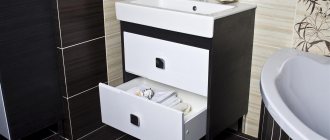Residents of apartment buildings are often faced with a situation where continuous or periodic noise in pipelines interferes with their comfortable living. To fix this problem with your own hands or with the help of utility plumbers, you need to establish the reason why the water pipes in the apartment are humming.
Solving the problem of eliminating disturbing noise is complicated by the fact that residential buildings use several types of pipeline communications: water supply, heating, sewerage. In addition to pipeline networks, sanitary fittings and equipment are often the culprits of uncomfortable sounds: stopcocks and valves, faucets, toilet flush tanks.
Since by the nature of sounds it is often possible to determine with high accuracy the source and cause of noisy interference, possession of this information will allow the homeowner to eliminate problems with his own hands or with the help of specialists in a short time and with a high degree of probability.
Rice. 1 Urban housing water supply
Types of faucets
Before you start repairing the device, you first need to find out what type of mixer tap you will be dealing with. This is due to the fact that each type has its own characteristics, which can become a source of problems if the approach to repair is incorrect.
Based on the type of pipe routing that supplies water, mixers are divided into vertical and horizontal. There are also subspecies, such as:
- two-valve;
- thermostatic;
- single lever;
- contactless.
Each of them has its own characteristics, knowledge of which will greatly simplify the work when troubleshooting future problems or breakdowns.
Structural features of cranes
Taste preferences and financial capabilities are two main factors influencing the choice of a mixer tap. Any type of product can be repaired, which can sometimes be carried out even by the owner himself. Let's take a closer look at the design features of these devices:
- Two-valve. Their obvious difference is the presence of two valves, which are adjusted separately. The crane axle box is the basis of such a product. Their weak point is the gaskets, which need to be changed quite often.
- Thermostatic. Their main advantage is the ability to pre-set the thermal regime of the supplied water. Such devices are not very popular due to their high cost.
- Single lever is the most popular type. Adjustment can be made by turning the tap to the side, or up and down. The basis of such a device is a ball mechanism. They gained popularity due to their simplicity, convenience and cost-effectiveness.
- Contactless. Built-in infrared sensors regulate the water supply - it is carried out at the moment when you bring your hands to the device.
Why is the faucet humming? There may be several reasons. Here are the main ones:
- Pipe wear. Why is the water tap humming? The fact is that any appliance has a service life, and if the house has not undergone major repairs for a long time, it is quite natural that the pipes began to hum due to old age.
- Poor quality repairs. Why is the hot water tap humming? If the technician connected the pipes incorrectly or poorly insulated them, they may hum and rattle.
- High pressure in pipes. Why does the faucet hum when you turn on the water? Why is the cold water faucet humming? There is only one answer - due to high pressure in the water pipes. This reason is far from uncommon, so before moving on to direct plumbing repairs, it is recommended to check the pressure level.
- Failure of the faucet shut-off valves is the most common cause of faucet rattling. Sometimes the rattling turns into a characteristic growl. The cause of the growling is faulty fittings. Also, if the hum of the mixer is observed only in your apartment, and not in the entire residential building, the problem is probably in the fittings. After replacing it, the noise most often disappears.
Let's look at each type of repair separately.
Reducing the internal diameter of pipes
Due to the reduction in the diameter of the pipes, a reactive flow of water is formed from the inside, creating vibrations that are responsible for the hum. How to diagnose in this case? To do this, you need to inspect the mixer after first disconnecting it. If you see dirt on the walls, this is a sign that the entire system is overgrown. Impurities contained in water are gradually deposited at the end sections of pipe systems. This means that you can still clean them.
Such blockages occur not only in steel pipelines, but also in polypropylene and plastic ones. This is due to the fact that the diameter of the pipe and hoses of the mixer is different, and this, as a consequence, leads to the formation of plaque.
Such blockages can be removed using pneumatic or hydraulic flushing. As a less effective option, mechanical cleaning can also be used.
Flushing involves the flow of a continuous strong stream of water through the water supply. Circulation and electric pumps are used to carry out flushing. It is worth noting, however, that this technique is ineffective when it comes to flushing large-diameter pipes. In this case, individual sections of the pipeline are flushed. The water drains from them, the pipe is disconnected, after which a specialist cleans the internal walls using a thick wire with a brush at the end.
If it is impossible to remove the blockage, the problem area should be disconnected from the general pipeline and replaced with a new one. Installation of a new pipe is carried out using special rubber seals.
If a single-lever type of faucet is humming
A single-lever mixer is usually one of the most reliable plumbing products. However, even this begins to fail over time.
Why is the bathroom faucet humming? The reason for the hum of a single-lever device is the wear of the plates located in the cartridge of such a faucet. In this case, the tap makes noise precisely when opening and closing the water. Another reason may be wear of the gasket (key).
Typically, cartridges are not repaired. Instead of an old cartridge, you simply buy a new one. Replacing the cartridge is very easy - you can easily do it yourself. You need:
- Unscrew the handle of the product.
- Remove the damaged cartridge.
- Replace the cartridge with a new one.
- Screw everything into place.
By following these simple steps, you can easily replace a failed key yourself.
Repair of valve mixers
Does your bathroom faucet hum when it's closed? When dealing with the valve type, the reason lies either in the wear of the valve box or in a flattened gasket. The gasket becomes deformed when tightened too tightly. Crane axleboxes come in two types: with rubber or ceramic liners.
Let's look at each product separately.
Crane axle box with rubber
A product with a rubber lining very often develops a characteristic whistle. Why does the faucet whistle? It's all about the cartridge again.
If you have a crane axle box installed with a rubber gasket, replacement is carried out as follows:
- It is necessary to remove the cover from the valve handle
- The faucet axle box is unscrewed from the mixer body.
- Using tools, you need to unscrew the washer responsible for fixing the gasket.
- A new key is installed, all unscrewed parts are returned back.
Such simple manipulations help eliminate the humming sound in the tap.
Crane axle box with ceramics
The first steps of replacing faucet axle boxes with ceramics are similar to those carried out with faucet axle boxes with rubber - you need to unscrew the ceramics from the mixer. After removing it you must:
- Pry off the cartridge with a thin screwdriver, as it is fixed in a special groove.
- After changing the gasket (cartridge), you need to make sure that you firmly fix the new gasket into this groove.
With these simple manipulations, you will effectively eliminate noise in your mixer tap.
Other faucet malfunctions
Besides humming pipes and faucets, there are a number of everyday problems associated with plumbing fixtures.
Most often, problems are associated with the fact that a plumbing product leaks in one place or another. This can be a kitchen and bathroom faucet, or a shower. Next, we will look at the most difficult difficulties and ways to achieve them.
Noise in pipelines is a discomfort
Residents of multi-storey buildings often encounter sounds (knocking, humming, whistling) that can be heard in various communication systems: plumbing, heating, sewerage.
Sometimes such noises are periodic in nature, in other cases they sound constantly, causing a lot of inconvenience to apartment residents.
Extraneous sounds in communications make life difficult. It is better to find out the cause of their appearance as early as possible and eliminate the noise.
It is important to know that buzzing and other sounds are not only unpleasant, but can also indicate serious problems in life support systems. Try to take immediate action by understanding the causes of the noise, without waiting for it to go away on its own.
When it leaks from under the nut
Very often, leakage occurs due to a loose nut. Therefore, first you should try to tighten the nut more tightly. If this doesn't fix the problem, it's most likely a gasket issue.
If water continues to leak, you should first dismantle and disassemble the product. Most often, the problem is a rupture in the seal. The key needs to be replaced.
To work you will need an adjustable wrench.
- Unscrew the nut.
- Remove the old key from the gander.
- Replace the old gasket with a new product.
- Wrap two layers of tape around the thread.
- Insert the gooseneck into place and tighten the nut.
Diagnosis of the problem
The reason for the hum in the pipes is turbulence of the flow, which appeared due to a leak in the connections of the plumbing elements. Leaks that occur in shut-off valves change the cross-sectional area of free passage inside the pipe space. This is how vortices appear that hum.
Air leaks due to leaks cause a series of hydraulic shocks, which cause vibration of the pipes. It often accompanies annoying sounds similar to a honking train.
When the shower gander switch leaks
In order to switch the water supply from the shower to the gander and back, we use a special lever. Sometimes it leaks too. What to do in this case?
As with most cases, the most likely source of the problem is a worn gasket. In order to fix the problem, you need to:
- Unscrew all screws and bolts from the lever (if they are missing, simply unscrew the lever from the mount).
- Remove the lever, remove the gasket, replace it.
- Place the lever back and, if there are screws, tighten them.
Ready! The switch no longer leaks.
Methods for clearing blockages
You are mistaken if you think that you just need to pour some unique liquid like “Mole” into the system and the problem will be solved. You'll have to work on your own. The blockage can be cleared in three ways:
- Hydraulic flushing.
- Pneumatic flushing.
- Mechanical cleaning.
Let's look at the flushing option first. This is the passage of water flow. To do this, it is not enough to simply connect a hose, so they use electric, fairly powerful pumps. However, this method can only remove blockages in small-diameter pipes. This method is not suitable for thick products. In this case, heavy particles will still have time to settle on the walls.
When the mixer valve leaks
The most common causes of leakage from under the valve are wear of the seal rings or breakage of the valve axle box. To carry out the repair you will need: new sealing rings, a screwdriver, an adjustable wrench, and a new valve axle.
- — Remove the plug from the valve and unscrew the fastening screw.
- — We remove the valve, dismantle the crane axle box.
- — If the entire crane box has become unusable, replace it completely. If the problem is simply thinning of the rings, replace only them.
- — Put the valve back on.
Now our valve is like new! Nothing else is leaking.
When the shower hose leaks
In most cases, the shower hose begins to leak precisely at the point where it connects to the faucet. Most often, leakage is associated with loose nuts. To start, try simply tightening the nuts tighter - sometimes this is enough to stop the leak.
If this does not stop the leak, it may be due to worn gaskets. In this case it is necessary:
- Unscrew the hose clamping nut.
- Remove the unsuitable gasket.
- Install a new cartridge.
- Apply two layers of insulating tape.
- Screw the nut into place.
If your hose has exceeded 15 years of service life, it is recommended to purchase a new shower kit. Towards the end of its service life, plumbing fixtures often begin to break down, and sometimes it is wiser to buy a new set than to repair the old one several times.
Although broken plumbing fixtures can be a huge inconvenience, many of these problems are easily remedied. In most cases, the owner can handle it on his own. However, in case of serious damage or difficulties in repairing it yourself, it is strongly recommended to call a specialist, because working plumbing is not only convenient and economical, but also safe.
Why does the toilet tank make noise when filling with water?
The toilet cistern may also be a source of increased noise in the apartment. According to the experience of repairmen, this problem can be easily solved on your own and quickly resolved. The most common cause of excessive noise is the intake mechanism.
The toilet tank can make noise just like the pipes
As a rule, when assembling drain fittings, a tube is placed on the inlet valve, which at one end descends almost to the bottom of the tank. When the water in the tank begins to fill and the tube closes, the noise disappears.
The reasons are no longer important - either the tube fell off on its own, or they simply forgot to install it during assembly. The main thing now is to eliminate the noise of water when filling the tank. If the tube falls off, you just need to put it back in place.
If the tube is lost, you need to select a suitable piece of plastic or rubber tube and secure it in the drain tank. Learn more about how to fix a toilet flush tank.











